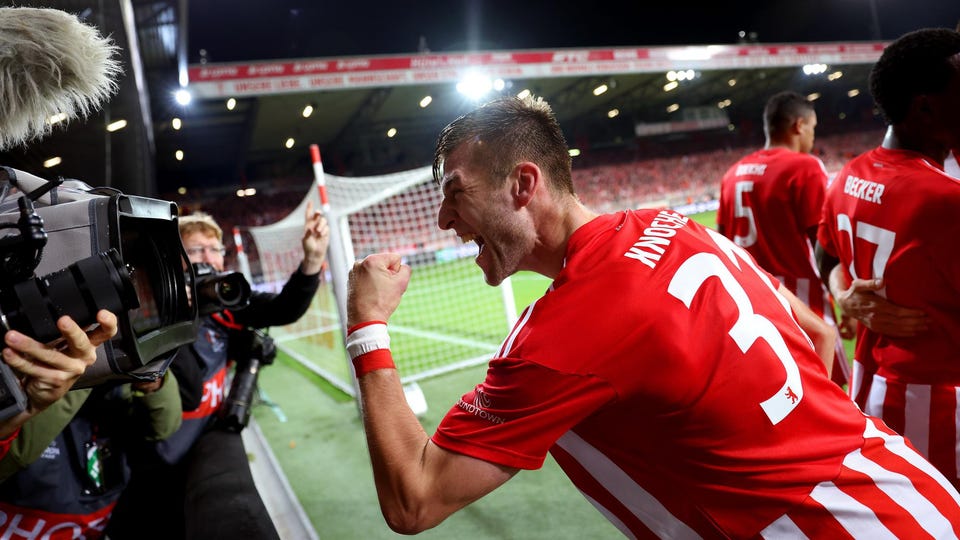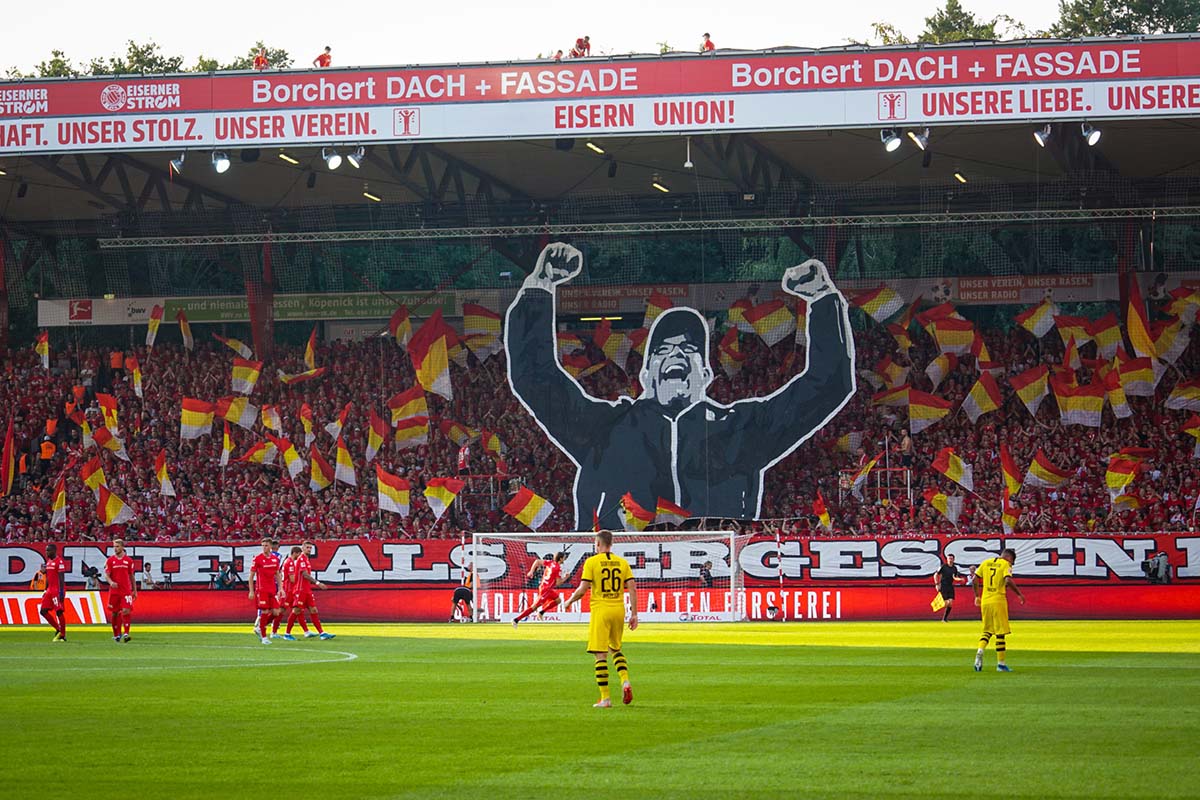The “hipster club” of Germany isn’t here for novelty anymore. FC Union Berlin is vying for titles, plural.
At this stage of the season in the Bundesliga, it would be reasonable to expect that Bayern Munich is well on their way to an 11th successive title. Over the last decade, Bayern dominance has become the norm in German football.
However, this season is playing out a little differently.
With 13 games to play, Die Bayern are joined at the top by regular challengers Borussia Dortmund and a new rival in 1. FC Union Berlin. All three teams find themselves on 43 points, with Bayern Munich currently maintaining a slight advantage on goal difference.
It’s no surprise that Dortmund is their closest competitor, but having Union still challenging at this stage of the season has been a complete shock.

Nicknamed, Die Eisernen (The Iron Ones), the side from the German capital has been punching well above its weight for quite some time now. They even jumped out to an early lead atop the table in September, though most expected them to peter out long before the World Cup break.
That seemed to be the case as they let their grasp on the top slip after two successive heavy away defeats to Bayer Leverkusen and SC Freiburg. But with five wins and a draw in their first six Bundesliga games since the restart, Union are well in the conversation for the title race.
A dive through Union Berlin’s history makes their 2022-23 title campaign all the more impressive.
A City Divided

The city of Berlin is an anomaly in European football, as it is one of the few capital cities on the continent that doesn’t host a footballing powerhouse. London, Madrid, Paris, Amsterdam, and Rome are all home to some of the biggest clubs in the world.
Whilst the people of the German capital are as big on their football as their successful Bavarian neighbors, Berlin hasn’t seen a first-division title since 1931. While that title belonged to Hertha, who hail from the west side of the capital city, it is a club from the opposite end of town that is making waves this season.
But being from East Berlin has a lot to do with 1. FC Union Berlin’s difficult footballing journey over the years. Allied forces dissolved all German organizations following World War II, which included football clubs. So while Union can trace their lineage back to 1906, the current evolution of the club only goes back to 1966.
Between 1949 and 1990, Berlin’s East/West divide made it difficult for football clubs in the East to thrive beyond their own regions. Die Eisernen had minor success in their early years, winning lower league titles in East Germany throughout the ’70s and ’80s.
Fellow East Berlin club BFC Dynamo became the club’s rival on the pitch. In the early years, Dynamo was funded and run by the Stasi Secret Police. Naturally, this led to those who despised the Secret Police being drawn to Union, helping shape their anti-establishment identity which became deeply embedded within the club.
Birth of the Bundesliga
In 1990, the Berlin Wall fell, and Germany reunited. As a result, German football established the first formation of the Bundesliga system.
1. FC Union Berlin began life in a united capital in the third tier of German football, then known as the Regionalliga Nord. They performed well on the field, but financial problems prevented any progression.
On multiple occasions in the 1990s, authorities blocked the club from gaining promotion to the second tier due to their financial issues and crumbling stadium.
In 2001, after winning the Regionalliga Nord title for the fifth time in 10 seasons, Union were finally allowed to progress to the second tier, 2. Bundesliga.
In 2005, after four seasons in 2. Bundesliga, the club slipped back down to the third tier, and even further down to the fourth tier one season later. As you could imagine, more financial woes plagued the club during this period. A blood drive provided by their loyal supporters saved Union from complete insolvency in 2004.
In 2008, the club was a founding member of the 3. Liga, creating a single-track league in the third tier of German football. Union would go on to win the inaugural league title.

However, money was still tight, and their stadium desperately needed modernizing, not just for upkeep reasons, but also to meet requirements for the 2. Bundesliga. Stadion An der Alten Försterei (Old Forester’s House) had been Union’s home since 1920. Located in the forest deep in East Berlin, the ground has always been one of the most unique in Europe.
So to avoid another promotion blockade, over 2,000 Union fans volunteered over 140,000 hours to help rebuild their stadium.
“This is the most unique experience of my career,” Sylvia Weisheit, figurehead of the fan-led construction project and lifelong Union Berlin supporter, told DW Radio in 2009. “The fans spend their free time and holidays working at the construction site. They are totally committed to the community, and any company would be glad to have such workers.”
The Promised Land
Die Eisernen remained in the 2. Bundesliga for the next 10 seasons, before a third-place finish in the 2018-19 2. Bundesliga table under Urs Fischer saw the club advance to a playoff for promotion.
A two-legged fixture against Stuttgart stood in their path to the Bundesliga.
Union drew the first leg 2-2 away in Stuttgart, which meant a low-scoring draw would be enough for Die Eisernen to reach the promised land. The second leg at the Stadion An der Alten Försterei ended in a 0-0 draw, and Union Berlin gained promotion to the Bundesliga on away goals. The result prompted a dramatic and emotional pitch invasion.
Union Berlin had become the first football club from the city’s eastern end to play football in the first division. During their first seasons in the Bundesliga, Union Berlin continued to defy the establishment. The stadium maintains three stands that are standing-only terraces. There are no screens to show replays, no goal music, and no pre-match or halftime entertainment.
Union’s minimalist approach maintains their long-standing objective. The club is for the fans. The fans are the ones who provide the noise and atmosphere in the stadium they literally built themselves, and football provides the only entertainment needed.
On the pitch, Union has provided just that, improving in every season so far in the top flight. In its first three Bundesliga seasons, the club has finished in 11th, seventh, and fifth, respectively.
Their progression has also earned European qualifications, with the club reaching the inaugural UEFA Europa Conference League for the 2021-22 season, and did one better to qualify for the 2022-23 Europa League.
Their European campaign this season has been a success so far, finishing second in their group and defeating perennial powerhouse Ajax in the first knockout round. The club now faces Belgian side Union Saint Gilloise in the round of 16.
Is the Impossible Possible?
The final chapter to Union’s storybook season is still on its first draft, but should things continue to play out like they have been, we could be in for an exciting finish. A high-octane match against Bayern Munich looms on Sunday, which ostensibly would have serious implications on the final outcome of the season.
It’s also important to mention that the club is in two other competitions — Europa League and the DFB-Pokal — in addition to the Bundesliga. Just as they have succeeded in European competition this season, Union have advanced to the quarterfinals of the domestic cup, where they will face off against 2018 champions Eintracht Frankfurt on April 4.
You could argue that trying to win all three competitions could shift the club’s focus away from its most important objective (and perhaps best shot at hoisting a trophy), the Bundesliga. But after all, it’d be fitting that the anti-establishment club that once chanted for the tearing down of the Berlin Wall during free kicks would be the one to knock Bayern Munich off their seemingly impenetrable throne.







